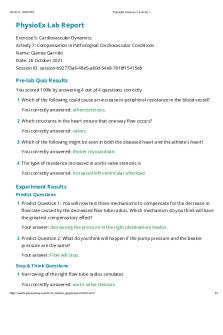Physio Ex Exercise 5 Activity 1 PDF

| Title | Physio Ex Exercise 5 Activity 1 |
|---|---|
| Author | Kyleigh Hankton |
| Course | Adv Human Anatomy & Physiology |
| Institution | Alcorn State University |
| Pages | 3 |
| File Size | 105.7 KB |
| File Type | |
| Total Downloads | 49 |
| Total Views | 136 |
Summary
The work for this class...
Description
2/4/2021
PhysioEx Exercise 5 Activity 1
PhysioEx Lab Report Exercise 5: Cardiovascular Dynamics Activity 1: Studying the Effect of Blood Vessel Radius on Blood Flow Rate Name: Kyleigh Hankton Date: 4 February 2021 Session ID: session-ba108512-4ce5-ca7d-60bb-a9ab77c0b876
Pre-lab Quiz Results You scored 100% by answering 5 out of 5 questions correctly. 1 Blood flow is measured in You correctly answered: ml/min. 2 Which of the following has the greatest effect on blood flow? You correctly answered: blood vessel radius. 3 Which of the following would not result in a decrease in the blood vessel radius? You correctly answered: vasodilation. 4 The diameter of the blood vessel is the same as You correctly answered: two times the radius of the blood vessel. 5 The opening of the blood vessel where the blood flows is called the You correctly answered: lumen.
Experiment Results Predict Questions 1 Predict Question 1: What do you think will happen to the flow rate if the radius is increased by 0.5 mm? Your answer: The flow rate will increase. 2 Predict Question 2: Do you think a graph plotted with radius on the X-axis and flow rate on the Y-axis will be linear (a straight line)? Your answer: no. Stop & Think Questions https://media.pearsoncmg.com/bc/bc_0media_ap/physioex/10/ex5/act1/#
i 1/3
2/4/2021
PhysioEx Exercise 5 Activity 1
1 What is the driving force for blood flow? You correctly answered: pressure gradient. 2 How does the body increase the blood vessel radius? You correctly answered: smooth muscle relaxation. Experiment Data Flow Rate (ml/min)
Radius (mm)
Viscosity
Length (mm)
Pressure (mm Hg)
4.0
1.5
1.0
50
100
12.6
2.0
1.0
50
100
30.7
2.5
1.0
50
100
63.6
3.0
1.0
50
100
117.8
3.5
1.0
50
100
201.0
4.0
1.0
50
100
321.9
4.5
1.0
50
100
490.6
5.0
1.0
50
100
Post-lab Quiz Results You scored 100% by answering 4 out of 4 questions correctly. 1 The variable that you altered in this activity was You correctly answered: vessel radius. 2 Vessel radius and fluid flow https://media.pearsoncmg.com/bc/bc_0media_ap/physioex/10/ex5/act1/#
i 2/3
2/4/2021
PhysioEx Exercise 5 Activity 1
You correctly answered: are directly proportional. 3 After a heavy meal, when we are relatively inactive, we might expect blood vessels in the skeletal muscles to be somewhat somewhat
and the blood vessels in the digestive organs to be
.
You correctly answered: constricted, dilated. 4 When you increased the flow tube radius, the fluid flow rate You correctly answered: increased.
Review Sheet Results 1 Explain how the body establishes a pressure gradient for fluid flow. Your answer: All fluids move from an area of higher fluid pressure to an area of lower fluid pressure. The blood vessel contract in one area and dilate in another area to direct blood flow. 2 Explain the effect that the flow tube radius change had on flow rate. How well did the results compare with your prediction? Your answer: As the radius increases the flow will also increase. When radius decreases the flow decreases. 3 Describe the effect that radius changes have on the laminar flow of a fluid. Your answer: Increase blood vessel radius increases the laminar flow. The decrease in blood flow radius decreases the laminar flows. 4 Why do you think the plot was not linear? (Hint: look at the relationship of the variables in the equation). How well did the results compare with your prediction? Your answer: The increase in blood radius resulted in a corresponding exponential increase in the rate of blood flow. Small increments in the radius resulted in larger increments in flow rate.
i https://media.pearsoncmg.com/bc/bc_0media_ap/physioex/10/ex5/act1/#
3/3...
Similar Free PDFs

Physio Ex Exercise 1 Activity 5
- 3 Pages

Physio Ex Exercise 5 Activity 1
- 3 Pages

Physio Ex Exercise 1 Activity 5
- 3 Pages

Physio Ex Exercise 5 Activity 1
- 3 Pages

Physio Ex Exercise 1 Activity 5
- 3 Pages

Physio Ex Exercise 5 Activity 5
- 3 Pages

Physio Ex Exercise 5 Activity 5
- 2 Pages

Physio Ex Exercise 5 Activity 5
- 3 Pages

Physio Ex Exercise 5 Activity 5
- 3 Pages

Physio Ex Exercise 6 Activity 5
- 4 Pages

Physio Ex Exercise 5 Activity 6
- 3 Pages

Physio Ex Exercise 5 Activity 6
- 3 Pages

Physio Ex Exercise 5 Activity 7
- 3 Pages

Physio Ex Exercise 5 Activity 4
- 3 Pages

Physio Ex Exercise 3 Activity 5
- 7 Pages

Physio Ex Exercise 5 Activity 6
- 3 Pages
Popular Institutions
- Tinajero National High School - Annex
- Politeknik Caltex Riau
- Yokohama City University
- SGT University
- University of Al-Qadisiyah
- Divine Word College of Vigan
- Techniek College Rotterdam
- Universidade de Santiago
- Universiti Teknologi MARA Cawangan Johor Kampus Pasir Gudang
- Poltekkes Kemenkes Yogyakarta
- Baguio City National High School
- Colegio san marcos
- preparatoria uno
- Centro de Bachillerato Tecnológico Industrial y de Servicios No. 107
- Dalian Maritime University
- Quang Trung Secondary School
- Colegio Tecnológico en Informática
- Corporación Regional de Educación Superior
- Grupo CEDVA
- Dar Al Uloom University
- Centro de Estudios Preuniversitarios de la Universidad Nacional de Ingeniería
- 上智大学
- Aakash International School, Nuna Majara
- San Felipe Neri Catholic School
- Kang Chiao International School - New Taipei City
- Misamis Occidental National High School
- Institución Educativa Escuela Normal Juan Ladrilleros
- Kolehiyo ng Pantukan
- Batanes State College
- Instituto Continental
- Sekolah Menengah Kejuruan Kesehatan Kaltara (Tarakan)
- Colegio de La Inmaculada Concepcion - Cebu